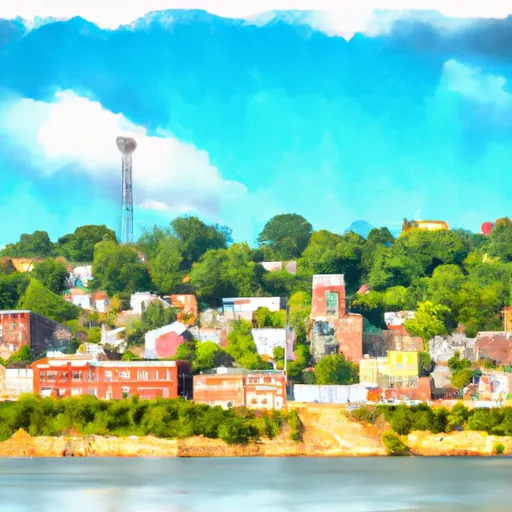-
 Snoflo Premium
Snoflo Premium
Get unlimited access to all our content
With no Ad interruptions! - Start Your Free Trial Login with existing account
Rockport
Eden Index
Climate
8.0
•
Recreation
2.8
•
Community
0.9
•
Safeguard
4.4/10

Rockport, Kentucky is a small town located in the southeastern part of the state. The climate in Rockport is considered humid subtropical, with hot and humid summers, and mild to cool winters. Average temperatures range from the mid-80s (Fahrenheit) in summer to the mid-30s in winter. Precipitation is evenly distributed throughout the year, with occasional snowfall in the winter months.
Rockport is situated near the Green River, which adds to its hydrology constituents. The river provides opportunities for fishing, boating, and other water sports. The area is also home to several small lakes and ponds, attracting anglers and nature enthusiasts.
Outdoor recreation in Rockport is abundant, with various opportunities available. The Green River and surrounding forests offer excellent hiking and camping possibilities. The area is known for its wildlife, making it a popular destination for birdwatching and hunting. Additionally, Rockport is close to the Daniel Boone National Forest, which provides even more recreational activities such as horseback riding, ATV trails, and rock climbing.
In conclusion, Rockport, Kentucky has a humid subtropical climate, with hot summers and mild winters. Its proximity to the Green River and Daniel Boone National Forest offers a range of outdoor activities, including fishing, boating, hiking, camping, and wildlife observation.
What is the Eden Index?
The Snoflo Eden Index serves as a comprehensive rating system for regions, evaluating their desirability through a holistic assessment of climate health, outdoor recreation opportunities, and natural disaster risk, acknowledging the profound impact of these factors on livability and well-being.
Climate Health Indicator (CHI): 8.0
Rockport receives approximately
1253mm of rain per year,
with humidity levels near 80%
and air temperatures averaging around
14°C.
Rockport has a plant hardyness factor of
6, meaning
plants and agriculture in this region thrive during a short period during spring and early summer. Most
plants will die off during the colder winter months.
By considering the ideal temperature range, reliable water supplies, clean air, and stable seasonal rain or snowpacks, the Climate Health Indicator (CHI) underscores the significance of a healthy climate as the foundation for quality living.
A healthy climate is paramount for ensuring a high quality of life and livability in a region, fostering both physical well-being and environmental harmony. This can be characterized by ideal temperatures, reliable access to water supplies, clean air, and consistent seasonal rain or snowpacks.
Weather Forecast
Streamflow Conditions
Green
Area Rivers
Green
Snowpack Depths
Green
Reservoir Storage Capacity
Green
Groundwater Levels
Recreational Opportunity Index (ROI): 2.8
The Recreational Opportunity Index (ROI) recognizes the value of outdoor recreational options, such as parks, hiking trails, camping sites, and fishing spots, while acknowledging that climate plays a pivotal role in ensuring the comfort and consistency of these experiences.
Access to outdoor recreational opportunities, encompassing activities such as parks, hiking, camping, and fishing, is crucial for overall well-being, and the climate plays a pivotal role in enabling and enhancing these experiences, ensuring that individuals can engage in nature-based activities comfortably and consistently.
Camping Areas
| Campground | Campsites | Reservations | Toilets | Showers | Elevation |
|---|---|---|---|---|---|
| Montgomery Rec Park | None | 515 ft | |||
| Point Mallard City Campground | None | 568 ft | |||
| Crane MWR Military | None | 594 ft | |||
| Glendale State Fish and Wildlife Area | 120 | 495 ft | |||
| Sunset City Park | None | 548 ft | |||
| Hoover RV Park | None | 483 ft | |||
| Rickwood Caverns State Park | 13 | 703 ft | |||
| West Boggs Park | 220 | 528 ft | |||
| Tannehill Ironworks Historical State Park | 300 | 435 ft | |||
| Harpeth River Bridge | None | 393 ft |
Nearby Ski Areas
Catastrophe Safeguard Index (CSI):
The Catastrophe Safeguard Index (CSI) recognizes that natural disaster risk, encompassing floods, fires, hurricanes, and tornadoes, can drastically affect safety and the overall appeal of an area.
The level of natural disaster risk in a region significantly affects safety and the overall livability, with climate change amplifying these risks by potentially increasing the frequency and intensity of events like floods, fires, hurricanes, and tornadoes, thereby posing substantial challenges to community resilience and well-being.
Community Resilience Indicator (CRI): 0.9
The Community Resilience Indicator (CRI) recognizes that education, healthcare, and socioeconomics are crucial to the well-being of a region. The CRI acknowledges the profound impact of these elements on residents' overall quality of life. By evaluating educational resources, healthcare accessibility, and economic inclusivity, the index captures the essential aspects that contribute to a thriving community, fostering resident satisfaction, equity, and social cohesion.

